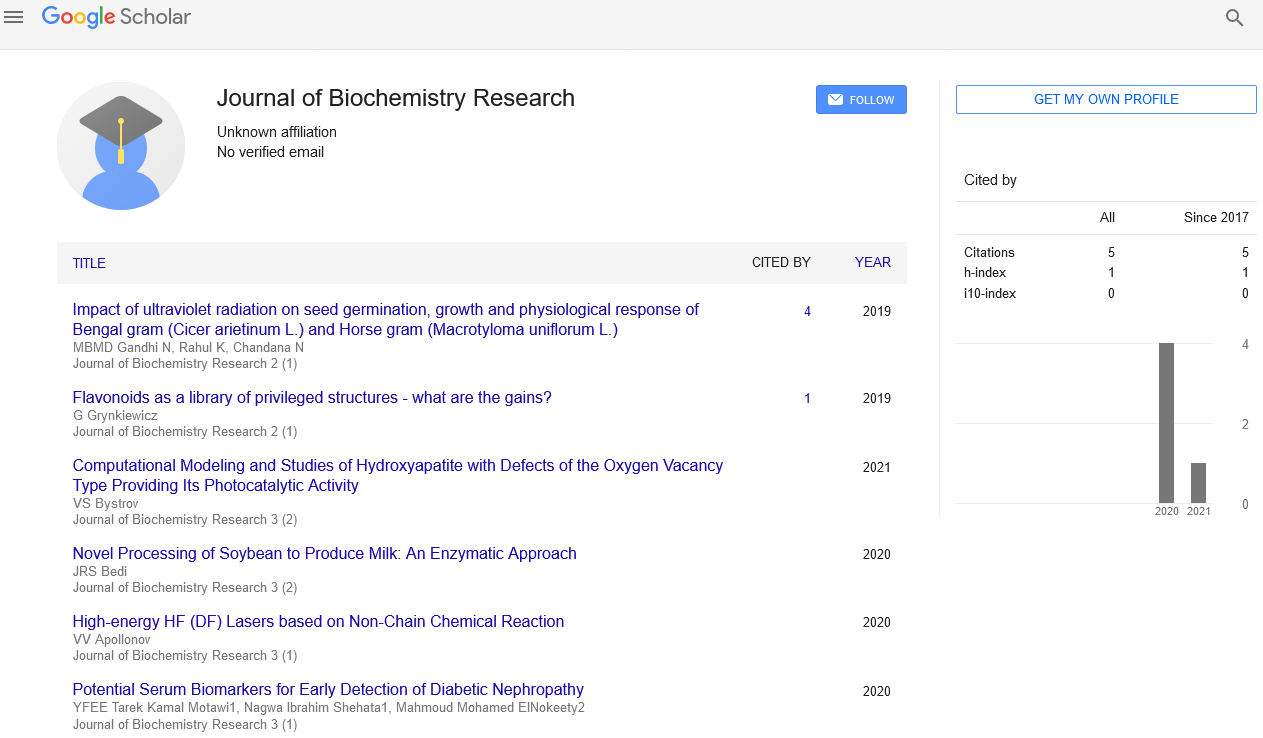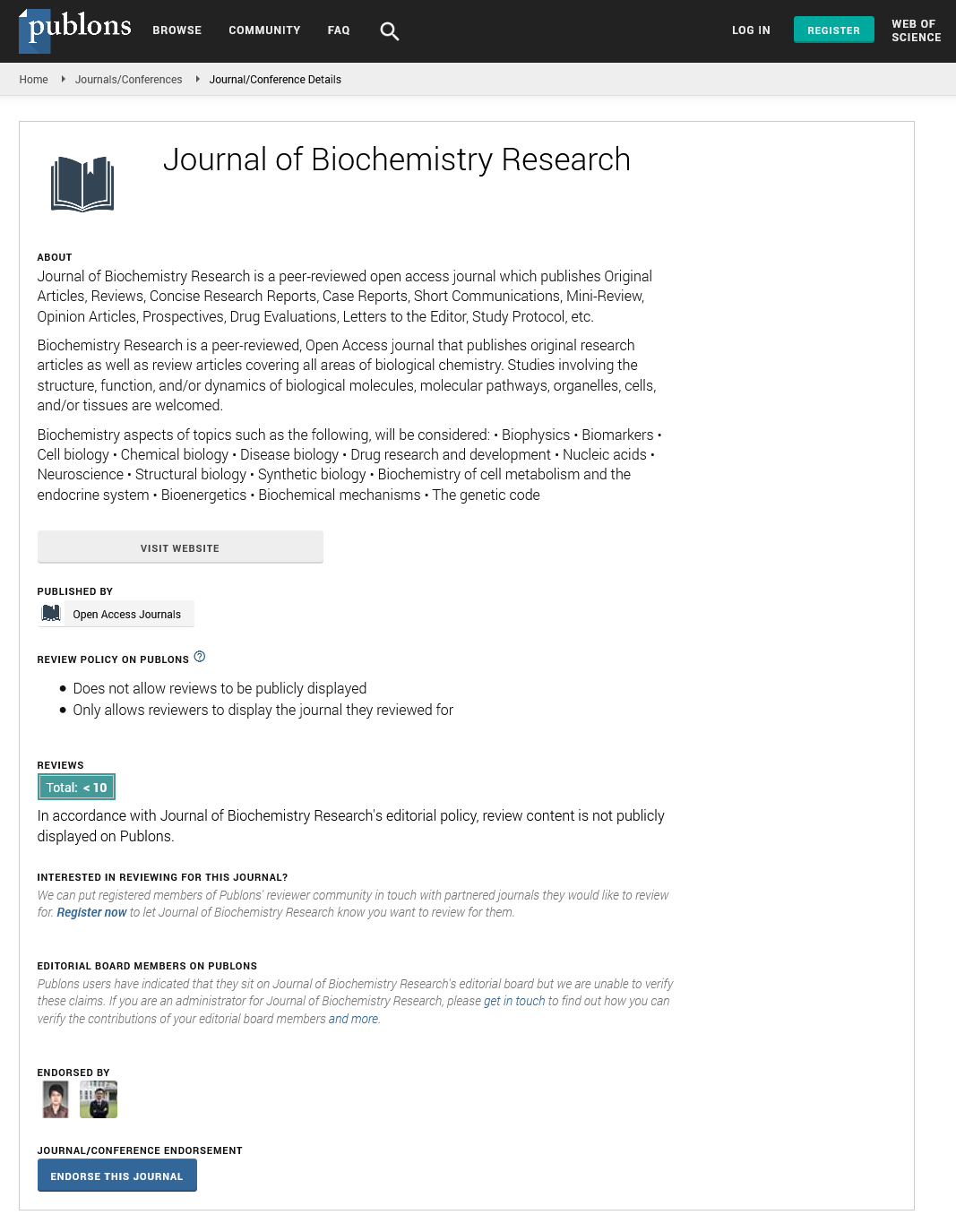Mini Review - Journal of Biochemistry Research (2023) Volume 6, Issue 1
The Endocrine System: Biochemistry of Adipose Tissue
Dr. Clara Gorton*
Department of Biochemistry, University of SBS (Biology Tissue Science), United States
Department of Biochemistry, University of SBS (Biology Tissue Science), United States
E-mail: cl.gorton@gmail.com
Received: 02-Feb-2023, Manuscript No. oabr-23-89009; Editor assigned: 06-Feb-2023, PreQC No. oabr-23- 89009; Reviewed: 20- Feb-2023, QC No. oabr-23-89009; Revised: 22-Feb- 2023, Manuscript No. oabr-23-89009 (R); Published: 28-Feb-2023; DOI: 10.37532/oabr.2023.6(1).13-15
Abstract
Numerous body functions, including growth and development, metabolism, electrolyte balance, and reproduction, are regulated by a plethora of hormones. Hormones are made in the body by a lot of glands. The pituitary gland is stimulated to release pituitary hormones by a number of releasing and inhibiting hormones produced by the hypothalamus. Some pituitary hormones affect other glands in different parts of the body, while others directly affect the organs they are intended to affect. The adrenal glands, which primarily produce cortisol, are among the body's other hormone-producing glands. The sex hormone-producing gonads; the gland that makes thyroid hormone; the parathyroid, which makes the hormone parathyroid; and the pancreas, which makes glucagon and insulin. A number of these hormones are part of regulatory hormonal cascades that involve a hormone from the hypothalamus, one or more hormones from the pituitary gland, and one or more hormones from the target gland. Adipose tissue is no longer regarded as a fat-storing inert tissue. Through pre-adipocyte differentiation and hypertrophy of existing adipocytes, this tissue can expand to accommodate increased lipids. The metabolism of adipose tissue has an effect on the metabolism of the entire body. Adipose tissue is an endocrine organ that is responsible for the production and release of numerous hormones. These are involved in a variety of processes, such as regulating dietary intake, regulating insulin sensitivity, and acting as mediators and pathways in the inflammatory process. Adipose tissue's biochemical and metabolic properties, as well as its connection to inflammatory disease and insulin resistance, are examined in this paper.
Keywords
Endocrine function • Hormones • Hypothalamus • Pituitary gland • Gonad function • Thyroid, parathyroid • Pancreas • Biochemical mechanism • Biological feedback • adipose tissue • Adipocytes
Introduction
In order for the body’s various parts and organs to function properly, they must communicate with one another to maintain a constant internal environment. For instance, neither the temperature of the body nor the levels of salts and minerals in the blood must go above predetermined thresholds. Additionally, communication between various parts of the body is necessary for the organism to be able to appropriately respond to any changes in the internal and external environments [1]. Communication is ensured by two methods: the hormonal system and nervous system in most cases, the nervous system lets information travel quickly between different parts of the body. In contrast, situations requiring more extensive and long-lasting regulatory actions are better served by hormonal communication, which relies on the transport of hormones through the bloodstream and the production and release of hormones from various glands. As a result, the two communication systems work well together. In addition, both systems work together: The release of particular hormones can be influenced by stimuli from the nervous system, and vice versa [2].
In general, the body’s metabolism and growth are controlled by hormones; the composition of bodily fluids’ electrolytes; and replication an overview of the hormone systems involved in those regulatory processes is provided in this article. Following a review of the various glands involved in those processes and the major hormones they produce, the article then provides a summary of some of the fundamental characteristics of hormone-mediated communication within the body. Endocrinology textbooks should be consulted by the reader for more in-depth information on these hormones [3]. Last but not least, the article discusses a variety of endocrine systems in which hormones made in a number of organs work together to produce the desired regulatory effects. The responses of the system in healthy, normal people are the primary focus of the discussions. The reader is referred to the following articles in this issue of Alcohol Health & Research World for information regarding alcohol’s effects on some hormone systems.
Adipose tissue’s biology has received a lot of attention, despite its initial status as merely a storage organ for triacylglycerol. The biology and biochemistry of adipose tissue has been the subject of a lot of experimental research in recent decades. It is no longer thought that this tissue is inert and only stores fat. In addition to being the primary storage location for excess energy, adipose tissue is an endocrine organ that is capable of synthesizing a number of biologically active compounds that regulate metabolic homeostasis. Adipose tissue is a metabolically dynamic organ. The stroma-vascular fraction, which includes blood cells, endothelial cells, pericytes, and adipose precursor cells, is another group of cells that make up this dynamic tissue in addition to adipocytes. Adipose tissue differs from one study to the next [4]. They differ in their capacity to secrete adipocytokines, cellular composition with varying phenotypes, and quantity and proportion of adipocytes, blood vessel stromal cells, and immune system cells depending on where they are in the body. Most people now know that adipose tissue is an important organ in a complicated network that helps control a lot of different biological functions.
Brown adipose tissue that is primarily responsible for the production of heat is present at birth but is absent in adults [5]. The average diameter of brown adipocytes is smaller than that of white adipocytes. They have a number of differentsized lipid droplets in the cytoplasm, a relatively abundant cytoplasm, a spherical core with a slight eccentricity, and numerous mitochondria that produce heat through fatty acid oxidation. Brown adipose tissue also stores energy in the form of lipids, but rather than providing free fatty acids for use by other cell types, it more frequently produces heat by oxidizing fatty acids within the adipocyte. The presence of numerous densely packed mitochondria and extensive vascularization give brown fat its color. It has many more blood vessels that go through it than white fat does. These blood vessels help transport heat produced by the numerous mitochondria to other parts of the body and transport fuel for storage and oxidation [6].
Lip Genesis and Lipolysis
Lip genesis is the synthesis of fatty acids, which are used as energy reserves. It takes place primarily in adipose tissue but also in the liver. Changes in diet can trigger this process [7]. Lip genesis is inhibited by polyunsaturated fatty acids and fasting, whereas it is stimulated by a high-carbohydrate diet that raises postprandial plasma triglyceride levels. Plasma-free fatty acids and plasma glucose levels both raise when people fast. Hormones, which either inhibit (leptin) or stimulate (angiotensin, acylation stimulating protein) lip genesis, partially mediate these effects. Lip genesis uses glucose as a substrate [8]. By preventing the pancreas from releasing glucagon and stimulating the release of insulin, it speeds up the process.
The process known as lipolysis occurs in adipose tissue and involves the hydrolysis of triacylglycerol molecules into free fatty acids and glycerol from energy reserves for energy production. The adipocyte’s triacylglycerol droplet is degraded during metabolic stress to provide free fatty acids for other tissues to use as a source of energy. Adipocytes can respond with lipolysis to a variety of stimuli [9]. However, the hydrolysis of the triacylglycerol ester bonds is ultimately catalysed by the same pair of enzymes, hormone-sensitive lipase and monoacylglycerol lipase. Breaking three ester bonds to release free fatty acids and a glycerol moiety is required for complete hydrolysis of triacylglycerol. Hydrolysis of the esters at positions 1 and 3 of the triacylglycerol is facilitated by the same enzyme, hormonesensitive lipase. The remaining ester is hydrolysed by a second enzyme, 2-monoacylglycerol lipase, to produce a third free fatty acid and glycerol. Insulin inhibits hormone-sensitive lipase, which is favored by the presence of glucagon and epinephrine [10].
Conclusion
The end products they influence play a fairly straightforward role in regulating the levels of some of the hormones. Therefore, the release of insulin and glucagon by the pancreas is the primary regulator of blood sugar levels. Other hormones, such as those from the HPA, HPG, and HPT axes, are components of hormone cascades whose activities are regulated by complex feedback mechanisms. In addition, the various hormone systems that control how the body works have numerous indirect interactions. Through their effects on cellular metabolism, hormones like GH and thyroid hormone, for instance, may alter blood sugar levels and, as a result, insulin release. In a similar vein, the effects that alcohol has on one hormone system may have indirect effects on other systems. This means that alcohol has an effect on how nearly every organ in the body works. When analysing alcohol’s effect on various hormones, which are discussed in the remaining articles in this issue, it is essential to keep this interconnectedness of neuroendocrine systems in mind.
Although it is recognized as an endocrine organ, adipose tissue serves as the primary location for the storage of excess energy. It is now generally accepted that adipocytes are a complex type of cell that produce a number of signals, including cytokines, hormones, and growth factors, that not only affect the cells around them but also target tissues involved in energy metabolism and influencing physiologic and pathologic processes. Leptin and adiponectin, the two prototypical adipokines that have beneficial effects on insulin action and lipid metabolism, have been the focus of much of the research in this field. Increases in fat cell number, size, or a combination of the two are hallmarks of obesity. In the obese state, the adipose tissue is infiltrated by inflamed macrophages that release TNF- and IL-6, thereby linking obesity, inflammation, and insulin resistance. There is also evidence that low-grade inflammation within the adipose tissue results in the deregulation of adipocytokine production, thereby contributing to the pathophysiology of MetS. Understanding the signaling pathways by which adipokines control metabolism and looking for new treatments for adipose tissuerelated diseases are becoming increasingly important.
Acknowledgement
None
Conflict of Interest
None
References
- Kittakoop P, Mahidol C, Ruchirawat S et al. Alkaloids as important scaffolds in therapeutic drugs for the treatments of cancer, tuberculosis, and smoking cessation. Curr Top Med Chem. 14: 239-52 (2012).
- Russo P, Frustaci A, Del Bufalo A et al. Multitarget drugs of plants origin acting on Alzheimer's disease. Curr Med Chem. 20: 1686-93(2013).
- Booth FW, Chakravarthy MV. Physical activity and dietary intervention for chronic diseases: a quick fix after all. J Appl Physiol. 100: 1439-40 (2006).
- Beccuti G, Monagheddu C, Evangelista A et al. Timing of food intake: Sounding the alarm about metabolic impairments? A systematic review. Pharmacological Research. 125: 132–141 (2017).
- Anderson JW, Ward K High-carbohydrate, high-fiber diets for insulin-treated men with diabetes mellitus. Am J Clin Nutr. 32: 2312-21 (1979).
- Chandalia M, Lutjohann D, von Bergmann K et al. Beneficial effects of high dietary fiber intake in patients with type 2 diabetes mellitus. N Engl J Med. 342: 1392-8 (2000).
- Schwartz SE, Levine RA, Weinstock RS et al. Sustained pectin ingestion: effect on gastric emptying and glucose tolerance in non-insulin-dependent diabetic patients. Am. J. Clin. Nutr. 48: 1413-7 (1988).
- Reynolds A, Mann J, Cummings J et al. Carbohydrate quality and human health: a series of systematic reviews and meta-analyses. Lancet. 393: 434-445 (2019).
- Carrillo JE, Carrillo VA, Perez HR et al. Defining and targeting health care access barriers. J Health Care Poor Underserved. 22: 562-75 (2011).
- Jones G, Steketee RW, Black RE et al. How many child deaths can we prevent this year? Lancet. 362: 65-71 (2003).
Indexed at, Google Scholar, Crossref
Indexed at, Google Scholar, Crossref
Indexed at, Google Scholar, Crossref
Indexed at, Google Scholar, Crossref
Indexed at, Google Scholar, Crossref
Indexed at, Google Scholar, Crossref
Indexed at, Google Scholar, Crossref
Indexed at, Google Scholar, Crossref
Indexed at, Google Scholar, Crossref


